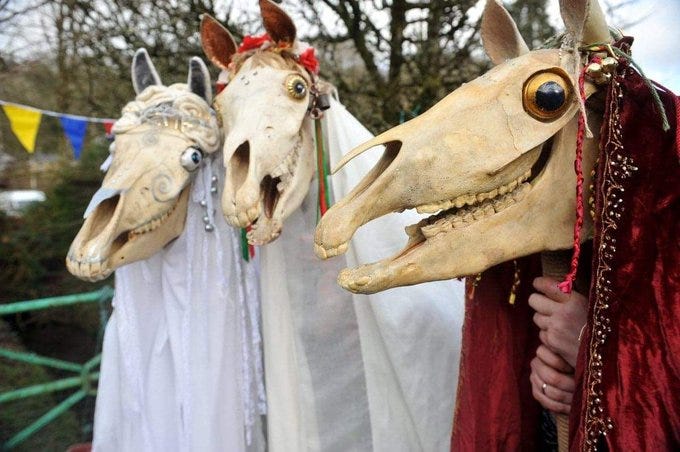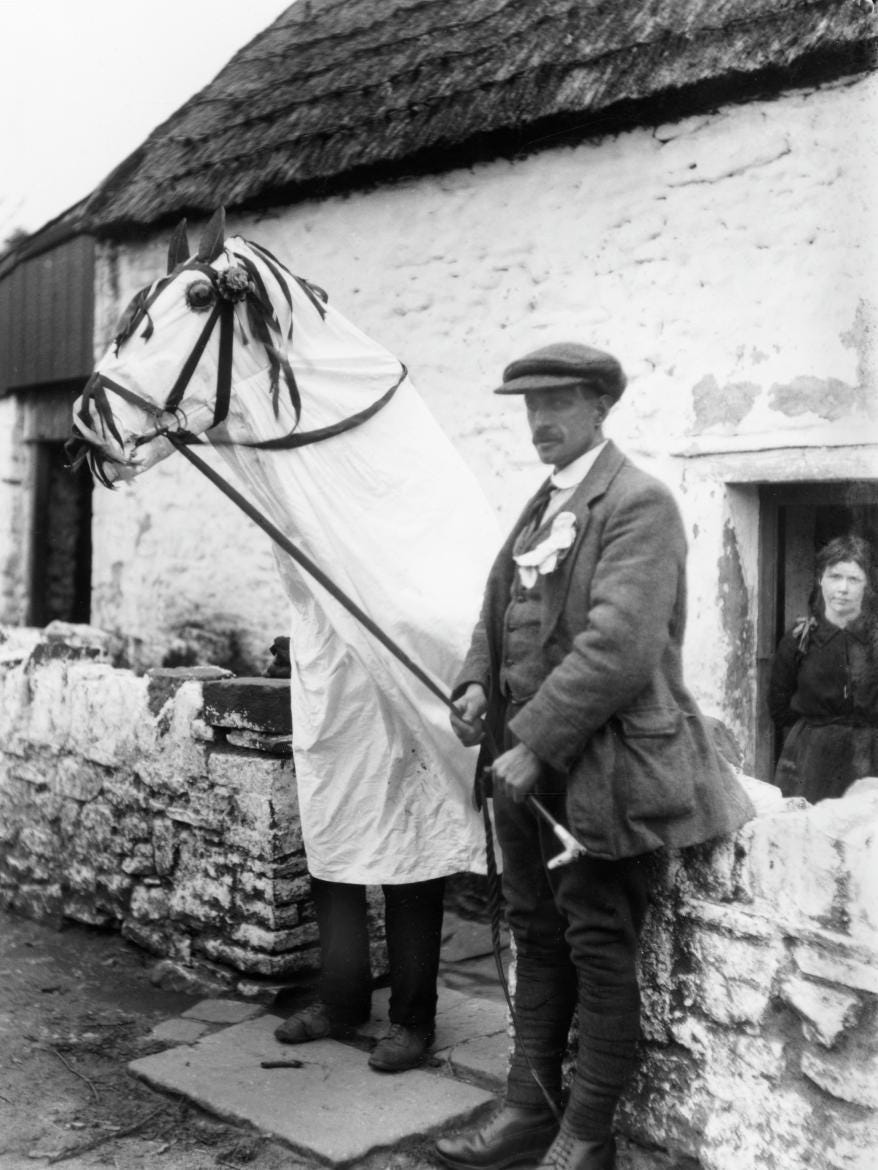Mari and the Merrymen
Every winter a ghostly horse emerges from the shadows, bringing song and merryment with her. Her name is Mari Lwyd; Wales' ultimate party animal.
If you are in Wales this winter, don’t be surprised to see a ghostly horse dressed in bells and ribbons, roaming the streets. The Mari Lwyd is not a spooky apparition but an ancient pagan tradition which has made one hell of a comeback.
Where Does Mari Lwyd Come From?
The exact origins of the Mari Lwyd are lost in the mists of time.
Her name, Mari Lwyd, translates as pale or grey horse. Folklorist Iorwerth Peate theorised that her name was a corruption of the Welsh for Holy Mary. This links Mari, a restless horse walking from home to home, to the folktale of a pregnant horse being cast from the Bethlehem stable where Mary and Joseph settled. While Mary gave birth to Jesus, the displaced horse roamed Bethlehem looking for somewhere safe to birth her foal.

The Mari Lwyd can also be linked to the white horse symbol which has been used in the UK since pre-Christian times. They regularly appear in Celtic mythology; for example in the Mabinogion, Rhiannon rides a white horse. Often white or pale horses were thought able to cross into the underworld.
The tradition of the Mari Lwyd is largely associated with South Wales, in particular Glamorganshire. However, the first recorded mention of a Mari Lwyd is in the 1800 book ‘A Tour Through Parts of North Wales’ by J. Evans.
Most commonly seen between Christmas day and twelfth night, the Mari may also appear at other celebrations such as Hallowe’en and May Day. Traditions similar to Mari Lwyd can be found in England, notably Hoodening in Kent and Old Tup in Nottinghamshire and Derbyshire.
The Mari Lwyd incorporates many elements of another old custom, wassailing. Wassail, from the Middle English wæs hæil or “be in health” was originally a sugared and spiced drink of mulled ale, roasted apples, curdled cream and eggs. During the festive celebrations, revellers would go from door to door requesting a drink from the wassailing bowl.
What Does Mari Look Like?
Mari rarely changes. Her head is almost always made from a horse skull. Following the end of the festivities the skull is buried in lime to preserve it for the following year. Sometimes wooden heads can be used; there is even an account of a Mari in Swansea in 1935 made from a pillow.
The skull is carried by a person hidden under a cloak or white sheet. Mari is dressed in ribbons and bells and may have lights or baubles for eyes. A pole is used to control the jaw, giving the impression that she can speak.
Mari is led from house to house by an ostler. They are accompanied by a host of other traditional characters including the Merryman, Sergeant, Lady and Punch and Judy. The presence of these characters shares links to Mummers plays of the 18th century.

Emerging at dusk, the Mari goes from house to house or pub to pub. Knocking on a closed door, Mari and her friends sing a song requesting entry. In response the house’s occupants, from behind the closed door, sing a song refusing Mari her request.
This starts a back and forth of improvised rhymes, often jokey or mischievous, known as ‘a pwnco’. These contests can last anything from a few minutes to a few hours before one side relents.
On the rare occasions when Mari loses the battle, she sings a final verse, begging for entrance. She would then be admitted, refusing Mari entrance was thought to bring bad luck, and the real festivities began.
Once inside, the merrymen would play music to accompany the singing and dancing. Meanwhile, Mari would run around neighing and snapping her jaws, frightening the children and generally creating havoc while its leader pretended to restrain her.
Mari and her party would be given food and drink (and sometimes money) before taking their leave with a farewell song. This performance would be repeated throughout the night, as Mari visited each house or pub in the area.
Mari Rises
As Welsh society became more devout, traditions such as the Mari Lwyd, which was perceived as an outlet for drunken rowdiness, were discouraged. Reverend William Roberts, a Baptist minister in the Gwent valleys, described her as “sinful” in his 1852 book ‘The Religion of the Dark Ages’. In the same text Roberts also transcribed 20 verses of the Mari’s performance, inadvertently helping to spread the tradition he was denouncing.
During the early 20th century, the decline of the Welsh language contributed to her downfall. With fewer people able to converse with or understand Mari, she found herself increasingly left out of festive celebrations. In the late 1930s and early 1940s, Iorwerth Peate found only a handful of Mari’s in Cardiff, Bridgend, Neath and other parts of Glamorgan.
By the 1960s just a few Mari’s were left, notably in Pencoed and Pentyrch.
However, a family in Llangwynyd near Maesteg decided to revive the tradition. 3 generations of landlords at the Old House Inn in Llangwynyd have now hosted the Mari. At the same time, members of Llantrisant Folk Club started their own Mari. Gradually, the old tradition started to spread further afield. To mark the start of the Millenium, Aberystwyth organised the world’s largest Mari Lwyd.
Today Maris are a common sight at midwinter, Christmas and New Years celebrations across Wales. So don’t be too surprised if you see a spectral horse dancing a band of revellers down the dark Welsh streets this winter.



